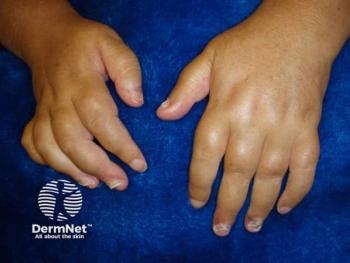
Labeling improves patient understanding of psoriasis topical regimens
Color-coded and picture labeling on topical psoriasis medications improved psoriasis patients’ knowledge and understanding of how to correctly use the medications, according to a study published April 10 in the Journal of Pharmacy and BioAllied Sciences.
An internal review of psoriasis patients’ topical medication use in a hospital-based dermatology clinic in Malaysia, where the researchers practice,
“There are many contributing factors to the poor outcomes of topical treatment, which include poor knowledge and insight of the disease, lack of motivation, and lack of explanation by healthcare providers on the benefit of treatments and their potential side effects,” according to the study.
RELATED:
Researchers did an unblinded randomized controlled trial at the dermatology clinic using two different types of medication labeling to determine if one would increase knowledge and decrease psoriasis severity.
Patients were randomized to either a color (C) and picture (P) labeling or conventional labeling group. Medication labels in the intervention group used the color red for topical steroids to indicated “danger” and use with care; yellow for keratolytic or tar preparations, indicating caution; and green for emollients, indicating these medications are safe.
“These colors were chosen based on the colors of the traffic light because it is easy to remember as most of the patients were familiar with it,” the authors wrote.
The labels also had pictures of body parts to help with site application. Topical steroid strength was labeled from mildly strong to very strong.
Researchers assessed patients at baseline, week 6 and week 12, gauging patients’ topical medication understanding with the Topical Application Assessment Score and measuring disease severity with body surface area, Dermatology Life Quality Index and Psoriasis Area and Severity Index tools.
A pharmacist counseled all patients at baseline on how to properly use their topical psoriasis treatments.
Ninety-one patients, most with mild-to-moderate disease, completed the study.
RELATED:
Researchers found patients’ knowledge increased in both groups with each visit. But the total knowledge scores at each visit were higher for the intervention group, with patients answering more questions correctly about each medication’s type of application, site of application, frequency of application and strength of steroids.
“At baseline, the higher [Topical Application Assessment] scoring in the intervention group showed that C and P labeling improved patients’ understanding more than conventional labeling,” the authors wrote.
While there were reductions in knowledge and understanding at week 6 in both groups, the reduction was greater in the conventional labeling group.
Among their other findings about patient understanding and knowledge, the researchers reported that many patients in both groups were unable to correctly answer the site of application for keratolytic or tar preparations.
“This may be due to the complexity of the treatment where these two medications need to be applied on specific types of lesions as compared to emollients, which can be applied anywhere on the body,” they wrote. “This is our duty as health workers to reinforce on patients’ education about the disease and its proper treatment.”
The researchers were not able to determine whether the better understanding translated to improved outcomes. While patients in both groups improved at every visit in body surface area and quality of life, the findings failed to reach statistical significance.
RELATED:
“Generally, doctors do not have enough time to explain the nature of a disease and the appropriate way to use the medications due to busy clinic and heavy workload,” the authors wrote. “Several studies documented that patients’ knowledge about the disease is important to ensure patients’ adherence to treatment and thus better outcome. Usually adherence to treatment is poorer in chronic diseases such as psoriasis due to various factors including difficulty in applying the topical medication, social factors, and treatment-related factors such as satisfaction with the treatment and complexity of the treatment protocols.”
The authors recommend further study using a bigger sample size, longer study duration, greater variations of education level and income, and multicenter study sites, including rural areas.
Disclosures: None. The study was not funded.
Reference
Mohd ali N, Lee CC, Mohd akhir NSN, et al. Effectiveness of color and picture labeling in improving the knowledge on topical medications among patients with psoriasis: A randomized controlled trial. J Pharm Bioallied Sci. 2020;12(2):201-2
Newsletter
Like what you’re reading? Subscribe to Dermatology Times for weekly updates on therapies, innovations, and real-world practice tips.


















